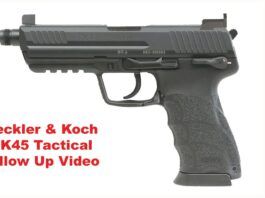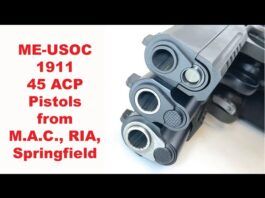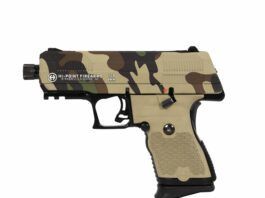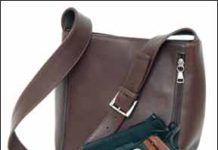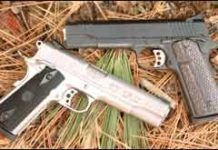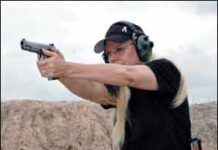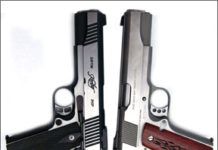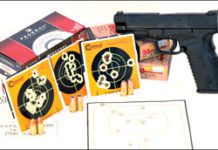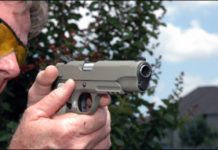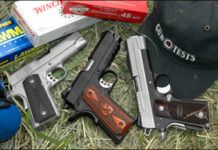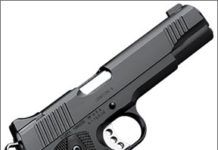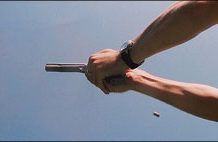Concealable Pistols: Foreign 9mms Vs. Domestic 45 ACPs
If Gun Tests' reader mail is any indication, the 9mm vs. 45 ACP debate is still a hot topic. Twenty years ago, the discussion might have been limited to arguing more rounds versus more effective ammunition. Whereas unexpanded 45 ACP slugs have an initial mechanical advantage — they measure about 0.451 inches across — the controlled expansion and fragmentation of modern 9mm ammunition has closed the gap in terms of terminal effectiveness. Still, questions about which round stops a fight the best will rage on, but for the purposes of this test of concealable handguns, our ballistic judgments will be limited to computing and comparing muzzle energies.
Instead, what we attempt to do here is resolve, in an admittedly small way, the classic gun-counter conundrum that readers constantly ask us about: When you're ready to plunk down hundreds or even thousands of dollars for a carry pistol, should you buy a simple-to-use polymer 9mm or a solid metal-frame 1911-style 45? This is such a personal decision that we know we cannot factor in all the variables that might come to bear, but in the broadest sense, the topic is worth tackling.
To represent the two calibers, we chose two lightweight 1911 45s. The $1076 Springfield Armory Lightweight Champion fires from a 4.0-inch barrel and offers an accessory rail. The $1662 Dan Wesson ECO also features an alloy frame but is smaller than the Champion. Barrel length was 3.5 inches. Standard magazine capacity for both pistols was seven rounds. To represent current 9mm technology, we acquired two high-capacity Caracal polymer pistols that are new to the scene. Imported by Steyr Arms from the United Arab Emirates, the Caracal F pistol was the larger of the two with a barrel length of 3.96 inches and magazine capacity of 18 rounds. The Model C, for Compact, operated with a 3.5-inch barrel and came with two 15-round magazines. Base suggested retail price for each model was $499, but our pistols had a $25 upgrade. Whereas both 1911s offered night sights, both of the Caracal pistols featured the Quick Sight system, wherein the rear sight was integral with the slide and its notch was located directly in front of the ejection port. There was a telltale cap on each Caracal where a traditional rear sight would be mounted.
Of course, the basic question the buyer has to resolve is whether he or she wants fewer big bullets or more smaller bullets. There are advantages to both strategies. But before you consider how the fight might end, we believe you should consider several other practical issues first, such as how a pistol carries and conceals, how well you shoot a particular handgun, and can you deliver an effective and fast first shot.
Before we get into the details, we wanted to note two points in particular. In terms of just plain old weight, everyone knows an empty polymer pistol like the Caracal is lighter than an empty 1911. But once loaded, it can end up being as heavy as a steel-framed 1911 45. Also, surprisingly, although the widths of high-capacity 9mm pistols have been shrinking, the 1911 still has the advantage of being narrower and easier to conceal.
In addition to evaluating our four main test guns, we wanted to further investigate the 9mm vs. 45 ACP question. Separately, we also shot two custom guns, the First 500 1911 45 from Cylinder & Slide and a custom-built Commander-sized 1911 chambered for 357 SIG. The Cylinder & Slide pistol was a replica of the first 500 Browning 1911 45 ACP pistols delivered to the military in the year 1911. Its basic feature package provided a backdrop illustrating the advances in sights, operational features, and weight reduction offered by our two test guns from Springfield Armory and Dan Wesson. The 357 SIG Custom Commander built by Ross Carter demonstrated the kind of power that can ultimately be produced driving a 9mm-sized bullet and showed how much weight could be saved by filling the magazine with 124-grain bullets rather than 230-grain slugs. Our impressions of those two firearms are included in an accompanying sidebar.
Little-Known 1911s: Remington And Taurus 45 ACPs Compete
In the gun world there's no shortage of 1911-type 45 autos. However, when an old company which made a few 45s during drastic times of national need around 1918 — but has made none since — brought out a fresh, U.S.-made 1911, it got our attention. Remington-UMC made a few 1911s long ago for WWI use, as did Singer Sewing Machine Co., and a few other companies. Remington apparently made something over 21,500 copies of the 1911 for WWI, and then quit — until now. After a very long wait we acquired one of the Remington Model 1911 R1 Enhanced 45 ACPs ($940 MSRP). We wanted a similar-priced gun to compare it to, so we went to another company not commonly known for producing 1911s, Taurus. Our test Taurus PT 1911 ($900 MSRP) was stainless, the only one we could get at the time. It had a forged slide and frame. Remington claims "precision machined" slide and frame, but we don't know if they began life as castings, forgings, or bar stock. At any rate, when we wrung ‘em out, this is what we found.
New 1911 45 Pistols For Less Than $1000: Ruger, Springfield, Magnum Research
The year 2011 marks the 100-year anniversary of the introduction of the John Browning's most successful pistol. The initial design was actually completed about 1907, but after acceptance by the U.S. Military some four years later, it became known as the 1911 and was chambered for 45 ACP (Automatic Colt Pistol).
To recognize this achievement, we found three affordable 1911-style 45s introduced in the year 2011. They are the Ruger SR1911 No. 6700 45 ACP, $799; Springfield Armory's $939 Range Officer; and the $799 Desert Eagle 1911G from Magnum Research. The introduction of yet another 1911 from Springfield Armory isn't surprising; the company has essentially built its formidable reputation on 1911 pistols. For Ruger and Magnum Research, however, these pistols are their first tries at producing 1911s.
All three models featured a 5-inch barrel on a full size frame offering a flat profile checkered mainspring housing below an enhanced grip safety. Thumb safeties were left side only. The front strap of each pistol remained smooth. Each pistol utilized an aluminum trigger that was lined at its contact surface and relieved to reduce weight. Only one gun, the Springfield Armory Range Officer, offered an adjustable rear sight. Only the Desert Eagle was fit with a full-length guide rod. The Ruger pistol alone was fit with three-dot sights and offered a noticeably taller magazine release button. Otherwise, these three pistols were nearly identical.
Besides their basic functionality, these pistols are interesting for another reason. They individually include advancements in 1911 design and finish that shooters of this time take for granted. To better illustrate some of these so-called advancements, we compared our test pistols to a 100th Anniversary, we shot them alongside a 100th Anniversary Limited Edition 1911 Government model from Cylinder & Slide (www.Cylinder-Slide.com). The retro-1911 is being built for production by Cylinder & Slide, Bill Laughridge's Fremont, Nebraska, custom house famous for the production of high-quality 1911 parts. On the outside of the current pistols, it is easy to see an improved grip safety, beveled magazine well, aluminum trigger adjustable for overtravel, oversized or ambidextrous thumb safeties, a lowered and flared ejection port, reduced mass hammer and high visibility sights both adjustable and low profile. Most of the upgrades that define the modern era 1911 were developed in the final quarter of the 20th century.
Today's features are supposed to help the operator shoot the gun faster, safer, and more comfortably, and those upgrades have become more economical. Not long ago, our test pistols would likely have sold in the $1400 range. The cost of high-quality 1911s first took a notable drop with the introduction of Computer Numerically Controlled (CNC) machining. This made accurately machined parts more abundant, reducing hand fitting.
Aluminum, Polymer, and Steel 45 ACP Semiautos Square Off
Aluminum, Polymer, and Steel 45 ACP Semiautos Square Off
1911 Range Showdown: Colt Has Heritage, but Places Third
When it comes to 1911-type handguns, most of us think of personal defense or tactical versions of the old warhorse; however, many are used for recreational shooting and informal target shooting. Recognizing that fact, our paper-punchers wanted to burrow down into the details of target-grade 1911 pistols to see what target sights, very tight slide-to-frame fit (some Army gunsmiths weld the barrel, slide, and barrel bushing to create a new standard of tightness, an option not available to most civilian shooters), and better trigger and barrel can produce in terms of accuracy. The goal was to choose which handgun was the most accurate and best suited for informal shooting and as a base gun for upgrades to more demanding competitions.
What we learned generally is that the primary advantage of such handguns are their adjustable sights. Adjustable target-grade sights allow the shooter to adjust his sights for a wide range of bullet weights. (The 45 ACP may be useful with bullet weights of 152 to 260 grains, but the 180- to 200-grain bullets are generally the most useful for target shooting.) Also, target-grade pistols offer a fine sight picture necessary for firing good groups at longer ranges.
We tested three target-sight-equipped pistols from Colt, Kimber, and Springfield. One was the Colt Gold Cup Trophy 05070X 45 ACP, $1050 MSRP, but which we found at a counter-retail price of $963. Kimber's Eclipse Target II was the next gun, priced at $1345 MSRP and counter price of $1160. The third gun of the trio was the Springfield Loaded Model Target P19132LP, MSRP $1069 and retail price $973.
We were lucky to be able to obtain two loads especially designed for accuracy, the Federal 185-grain full-metal-jacket semi-wadcutter and the Cor-Bon 230-grain Performance Match. We also used a handload worked up just for this project, using the Oregon Trail 180-grain SWC. With these rounds we used an established method to zero a pistol with adjustable sights. If the pistol is close to the zero you want from the factory, minimal effort is required to zero the sight. If not, more work is needed. First, however, the shooter must determine click values, which will vary from sight to sight. To measure click value for each gun, we took a good benchrest position and fired a three-shot group. Next, we clicked the rear sight wedge notch five clocks to the right, then fired another group. We then measured the amount of adjustment, allowing us to precisely calculate the exact number of clicks needed to zero the piece, or the exact movement made by a single click. It doesn't matter whether you do the vertical or horizontal clicks first, but both directions need to be measured.
Also, before we get into the guts of these guns, it's worth noting at this point that some target pistols get battered to death by firing full-power ammunition—an easily avoided problem. The oft-repeated advice of fitting a full-power Government Model recoil spring to the Gold Cup is a non-sequitur. The recoil spring is full power. It is the hammer spring that is clipped and lightened to provide less resistance so that the slide will cycle with lighter loads. The Gold Cup is also supplied with a second lightweight recoil spring. Hardball or 230-grain FMJ loads usually break 830 fps. It is possible to work up a load using a 185-grain bullet at 750 fps with a proper lightweight recoil spring. Naturally, a handgun sprung in this manner would quickly batter itself into a rattling wreck with hardball loads.
Polymer 45 ACP Pistols From SIG Sauer and Springfield
As recently as the September 2010 issue of Gun Tests, we referred to our evaluation of two similar 1911 45s as being something of a rarity. That's because the guns were essentially a different interpretation of the same design. More often, we compare a roster of test guns that, despite being of the same caliber and approximately the same size, end up demanding widely different skill sets to operate.
In this test we once again evaluate two closely related firearms chambered for 45 ACP ammunition. They are the $709 Springfield Armory XDM 45 XDM945BHC and the $712 SIG Sauer P250 45 Full Size 250F-45-BSS. Both pistols are full-sized guns with polymer frames and a barrel length of 4.5 inches. Each gun offers an accessory rail, low-mount sights, double-column magazines, and a measure of ambidextrous features.
On the surface it would seem that this was indeed another "apples to apples" test. But one noteworthy difference between the two pistols puts these guns in different categories, we believe. The trigger on the XDM 45 requires a takeup and press that was much shorter than that of the SIG Sauer P250 45. That was because the striker inside the XDM 45 is primed to a point just short of ignition by movement of the slide. However, the XDM 45 is categorized as a double-action pistol. This is based on the actions of pressing the trigger renders final compression and release of the striker. In a more obvious display of double-action form, the SIG Sauer operator has almost complete control of the ignition cycle. Pressing the P250's trigger rearward results in nearly a 1:1 ratio in terms of lifting the hammer and dropping it on the firing pin. Some shooters may find this difference too much to overcome, smashing our presentation as a test of similar guns. But as shown by the results of our rapid-fire tests, our staff found that both triggers could be operated quickly and effectively.
Our tests for accuracy were performed from a bench at the Top Gun of Texas indoor shooting range, www.topgunrange.com. We took full advantage of Top Gun's 20-yard bays and the slick mechanical target retrieval system recently installed by Action Target. Away from the heat and marauding showers in the Texas outdoors, we liked the privacy and safety afforded by the sizable ballistic barriers that separated us from other shooters. Accuracy testing was a slow-fire exercise, but we used an electronic timer to record our first shot and total elapsed times during our two action tests. Our first action test was performed from the 7-yard line with the shooter holding the gun in both hands and the front sight held at the lower edge of the shooter's peripheral vision. Our target was the IPSC-P (paper) targets from www.letargets.com. The action consisted of firing two shots to the body (a 5- by 9-inch rectangle A-zone), and one to the head. The head area measured 6.9 by 6.3 inches overall with a 4-inch-wide by 2-inch-tall A-zone, which on a human target terms would mask the eyes. We recorded ten separate runs.
In our second action test we wanted to know more about keeping the gun mounted in the hand throughout rapid fire. So, for this test the start position was with the gun directly on target held only in the shooter's strong hand. This meant our right-handed test shooter fired holding the gun with only the right hand. The IPSC-P target was placed 5 yards downrange and we concentrated on head shots only. Five runs of two shots each were recorded.
Test ammunition included 185-grain and 200-grain Hornady Custom XTP jacketed hollowpoint rounds. We also tested with the least expensive rounds we could find. They were Federal 230-grain FMJ rounds purchased for less than $17/50 from Walmart. Our action tests were performed using the 200-grain Hornady ammunition. Here's how we rated them:
Full-Size 1911s with Accessory Rails: Kimber vs. Double Star
When it comes to producing a Gun Tests evaluation, the process can be complicated by differences in operation. For example, a tight protocol, such as 9mm polymer pistols with 4-inch barrels and identical capacity, can challenge our test staff to master a different trigger for each gun. That won't be the case here, because the operational differences in these two guns are subtle, despite their vastly different cosmetics.
Our 45 ACP test guns were the Kimber Desert Warrior, $1441, and the Double Star DSC Combat Pistol, $1350. Despite having so much in common with the Kimber, the appearance of the DSC Combat Pistol could not have been further from that of the Desert Warrior. If you love the way your AR-15 "black gun" looks, the Double Star Combat Pistol provides a matching sidearm. Only the stainless-steel barrel hood and aluminum trigger broke up the understated color scheme. In contrast, the choice of color and the unusual grips found on the Desert Warrior set the gun apart from other 1911s. Officially, the color of the frame and slide were Desert Tan, but it could also be called khaki. The appearance of a lanyard loop at the bottom of the mainspring housing was also a distinctive touch.
To get started with the test, we first made sure each gun was lubricated. These are steel guns with a lot of metal-to-metal contact. We lubricated the slide and frame rails, the disconnector, the swinging link, each side of the hammer and along the outer surface of the barrel. The barrel lugs were lubricated by filling the matching wells beneath the slide with BreakFree CLP oil.
We began our tests by cleaning out the ammo closet, shooting each gun with a variety of rounds, including 200-grain lead semiwadcutters from Black Hills Ammunition. We then settled in at [IMGCAP(2)]our bench along the 25-yard line. Here we fired 10 round groups from a sandbag rest. Our test ammunition was Wolf 230-grain Copper FMJ with steel cases and non-corrosive primers, 200-grain JHP/XTP +P Hornady rounds, and Federal 230-grain Hydra-Shok JHP ammunition.
Our big question: Since the guns were essentially the same mechanically, would the statistical results be a dead heat? Or would our guns exhibit distinctly different personalities? Let's find out.
Short 45 ACPs from Sig Sauer, Kimber, and Springfield Armory
Short 45 ACPs from Sig Sauer, Kimber, and Springfield Armory
Wild Bunch Pistols, Part II: Kimber Wins Modern Guns Test
In our May 2010 review of pistols suited for Cowboy Action's widely popular new Wild Bunch side match, we noted two different categories of 1911s eligible to compete. There are two SASS classes set forth for 1911 handguns, which roughly correlate to the traditional and modern single-action class.
In our first review of handguns suited for the SASS Wild Bunch category—named in deference to the Sam Peckinpah movie, The Wild Bunch—we covered five traditional GI-type handguns from Springfield Armory, High Standard, and Colt. Prices ranged from $500 to $1000, a fairly large spread. The Springfield pistols included the GI Model, a stainless GI, and the Mil-Spec. The High Standard pistol was the 1911A1, and the Colt, the 1918 Black Army.
Recapping those guns, we said the Springfield Armory GI PW9108LP 45 ACP, $643, was the archetypical Wild Bunch pistol, meeting the rule specifications to a "T". The pistol features fixed sights, standard controls, and checkered plastic grips. We gave it a B+. Next, the Springfield Armory Stainless GI PW9151LP 45 ACP, $693, was identical in features to the Parkerized GI pistol reviewed above. For a modest additional cost, the stainless GI pistol offers an excellent appearance. Our testers said it was easily the best-looking handgun in the matchup. Still, it scored a C grade based on its poor accuracy and initial malfunctions. The third Springfield was the company's Mil-Spec PB9108LP Parkerized 45 ACP, $753, which earned an A grade and a Best Buy recommendation for its superb accuracy and flawless function.
The two non-Springfield guns were the High Standard 1911A1 HSTX1911 45 ACP, $480, a ‘B'-rated gun, which we said was not the best-finished pistol, but it worked and gave adequate accuracy. Last was a Colt Black Army 1918 No. 01018 45 ACP, $1000, the most expensive pistol tested, which also earned an A grade and was our team's favorite.
The "modern" class of 45s we test this month nods to the notion that quite a few SASS members probably already own such a handgun, and interested shooters from other disciplines may jump in to shoot Wild Bunch matches. The handguns legal for use in this category are middle-of-the-road pistols. High-visibility sights without night inserts are allowed and so are forward cocking serrations and full-length guide rods. Checkered grip straps are not allowed. Your Springfield TRP and Kimber Gold Match are not legal. We eliminated a number of capable 1911 handguns in the same price range because of the frame checkering and stippling limit. Getting something for free is an advantage, but in this case the advantages were "illegal" for competition.
Our Kimber entry was the Custom II 45 ACP, $828, which has been available for more than a decade and remains an excellent buy among 1911 handguns. Set against it was the Para Ordnance PXT 7.45 45 ACP, $986, and another Springfield, the Loaded Model PX9109LP 45 ACP, $1035.
Since SASS rules demand lead bullets running at less than 1000 fps, our test program for these guns was different. Personal defense was not a consideration, and neither was jacketed hollowpoint bullet performance. The choices among factory ammunition are limited. From Black Hills, we chose a 230-grain roundnose lead load and a 200-grain semiwadcutter. Then we worked up a handload using the Oregon Trail 200-grain semiwadcutter over 5.5 grains of WW 231, a proven accuracy load. It was essential each handgun perform well with these typical match loads.
In the previous test, all of the GI pistols and the modern Loaded Model in this test were Series 70 types, with no firing pin block, although the Springfield pistols offer a lightweight firing pin and extra power spring. Among the modern guns this round, the Para Ordnance is a Series 80-type pistol with a positive firing pin block, and the Kimber Custom II uses the Schwarz-type firing pin block.
We don't think that obtaining an original-period Colt 1911 is the best route to compete in SASS's Wild Bunch matches. They are expensive, with the cheaper samples beginning at $1000. The older pistols were of softer steel than we use today, and commonsense tells us a shooter pistol from the era is probably well worn.
Here's what we learned about the second round of Wild Bunch guns:





























